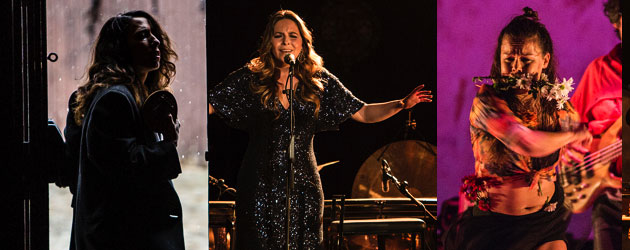Text: Silvia Cruz Lapeña
Fotos: Ana Palma
On Andalusia’s regional holiday, three artists shone brightly at the Festival de Jerez with original daring dance and singing
It was Jerez, and it was Andalusia’s regional holiday. And three daughters of flamenco performed at the Jerez Festival, and they were all good. Good for having been excellent, not obedient, because the three showed how far you can go doing what you want, knowing what you’re doing.
Ana Morales opened the day’s program with a piece that’s a sketch of another to be included in Canciones para el Silencio, a work to be presented at the next Bienal de Sevilla. She explained it would be so titled because her father was a man of few words, and flamenco was a way of getting close to him and trying to know him. The Barcelona artist danced making use of her inner self, superlative, and of her expressive capacity, which is considerable. Her other strong point is the connection with the audience, something that comes naturally to her. She explored her feelings, she was moving, dancing in a mainly contemporary register, wearing leotards, to electronic music, as well as a serrana with bata de cola, sung by Juan José Amador. She also did a lovely sensual pas de deux with José Manuel Álvarez, a Barcelona dancer with fine taste, who was an elegant partner who served Morales as a reference, almost using him as a mirror.
In the early evening at the González Byass winery, Rocío Márquez performed with the musicians of Proyecto Lorca presenting the live performance of her most recent recording, Firmamento. To say she is perfect, falls short because to say Márquez has perfect tuning and attends to every detail, is to repeat what is already known. The important thing is the strength she picked up on stage, something difficult to measure, but which the audience notices, and she grows with this. The show would have been impossible without these musicians: Juan Jiménez on sax, Daniel B. Marente on piano and the impossible to classify genius of Antonio Moreno who made the percussion a world apart. They did material from the record with some variations, and if I had to choose one moment, it would perhaps be the minera “En el pozo María Luisa”, better-known at “Maruxiña”, the hymn of miners from Asturias and León. Because that is precisely the best part of this record and this performance, the mixture of references and geographies, of beauty and statement and exquisite taste with which disparate sounds are juxtaposed and allowed to contaminate one another.
At night, at the Villamarta Theater, it was Rocío Molina’s turn with her Caída del Cielo, a work that comes broken-in after last year’s suspended performance in Jerez due to the artist’s illness. Molina has changed some things since the debut, but the humor and divertimento are intact, which the Málaga dancer uses to speak in many ways about being a woman. Her dancing, brave and impeccable, is of a type that today, only she can execute. She goes for broke in every step, expanding her repertoire of movements with each performance, and making it all seem normal, which is nearly a miracle. Her musicians are also delightful. Not only because they know her well, but because they are giving at every point, they correct, help and add. Especially noteworthy is the work of José Ángel Carmona who has a very flamenco sound, whether it’s interpreting “Vuelta de Paseo” in the style of Enrique Morente’s Omega, or soleá, guajira and rumba.
After these three shows, I felt like asking these ladies to form a political party and govern Spain. Not only because each one represents her territory, Barcelona, Huelva and Málaga, they brought song-forms from Seville, Madrid and even Asturias and filled the day and the night with verses by Isabel Escudero, Cristina Rosenvinge and Leonard Cohen. If I felt like asking them to do this, it was because in each show there were qualities that are all too scarce: truth, beauty, justice and liberty.
